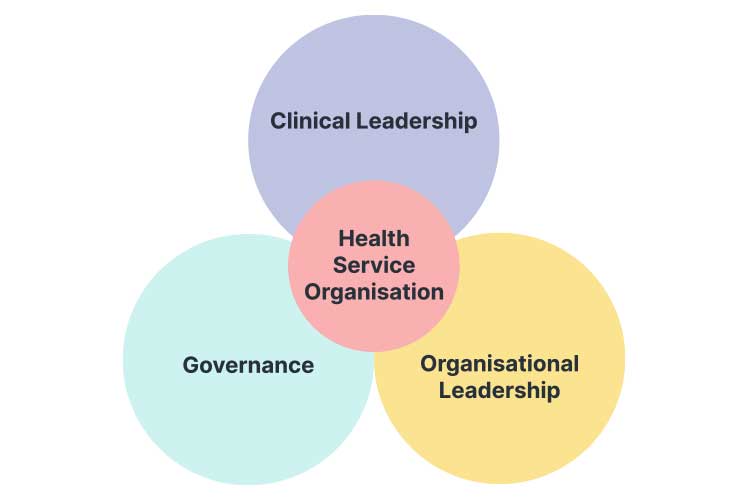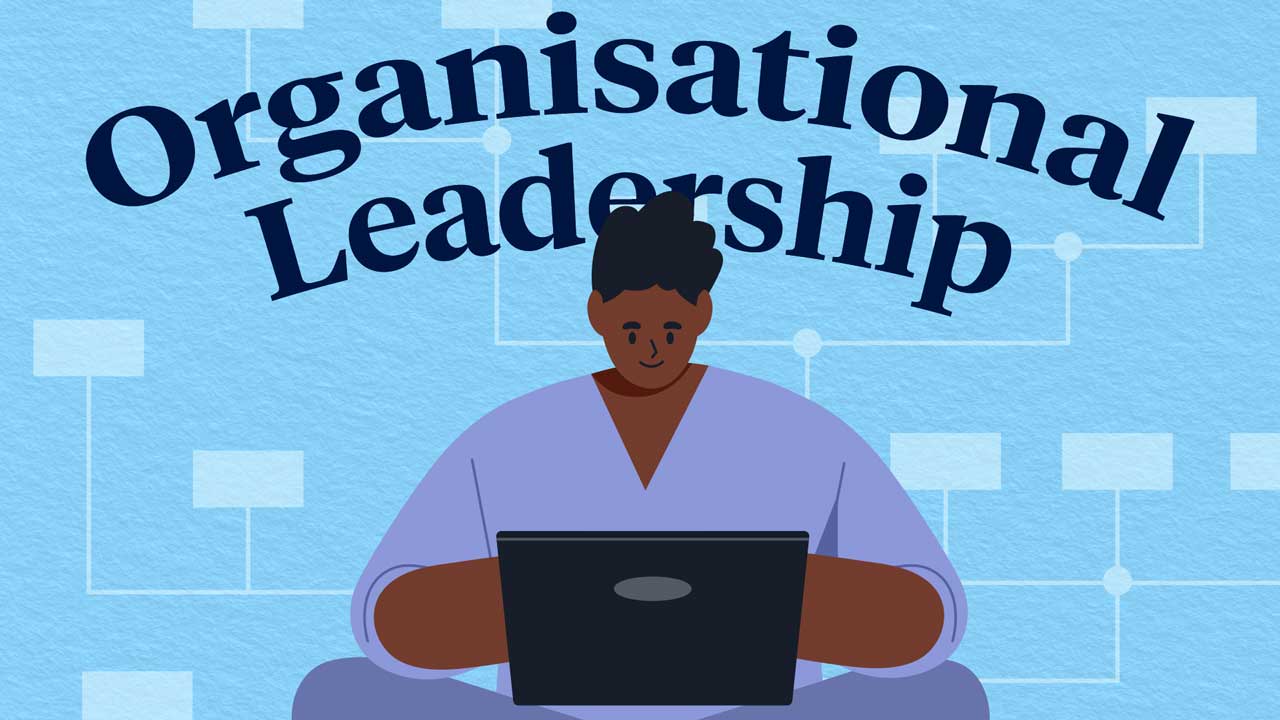Effective leadership is essential to providing high-quality healthcare (UTS 2022).
So essential, in fact, that leadership has been directly identified by Australia’s National Safety and Quality Health Service Standards as a key component of a safe and high-quality health system. NSQHS Standard 1: Clinical Governance, outlines three aspects of leadership that work towards this goal. These are:
- Governance, leadership and culture
- Organisational leadership
- Clinical leadership.
(ACSQHC 2021)
A healthcare organisation’s overall governance, leadership and culture, at the highest level, is provided by a governing body. The governing body may be:
- The chief executive officer
- The owner of the organisation
- A partnership with the organisation
- Any other group or individual who has the highest level of governance in the organisation.
(ACSQHC 2019a)
Clinical leaders ensure that staff members are upholding their safety and quality responsibilities and operating within the scope of policies and procedures that have been established. They are expected to supervise staff, conduct performance reviews, report on safety and quality and ensure that staff understand what is expected of them (ACSQHC 2019b).
So, What is ‘Organisational Leadership’?

Organisational leadership falls between governance and clinical leadership. Under directions from the governing body, organisational leaders are expected to design and implement policies and procedures to ensure the organisation’s mission is met in a safe and effective manner. These policies and procedures will then be practised and upheld by clinical leaders and staff (ACSQHC 2019c).
What Happens if Organisational Leadership is Ineffective?
A healthcare organisation’s success depends on its leadership and culture, and the actions taken by leaders set the basis of an organisation’s tone (DHHS 2020; AICD 2020).
As an example of poor organisational leadership in healthcare, let’s look at a case examined by The Royal Commission into Aged Care Quality and Safety.
The Commission investigated a money-saving strategy implemented by the governing body of an aged care provider in Tasmania, which led to adverse outcomes and the sanction of a facility (Alderslade 2019).
The provider had attempted to save money by using only 60% of operational income on operational costs. However, this resulted in many adverse effects felt not only by clients but staff and management too. Issues included:
- Substandard client care
- Staff dissatisfaction with upper management
- Staff not feeling adequately supported
- Managers not feeling adequately supported
- Staffing cuts.
(Alderslade 2019)
Ultimately, the provider failed 18 out of 44 accreditation standards due to ‘lacking efforts’ from the Board and upper management (Alderslade 2019).
While the governing body ultimately took the blame for the failed money-saving strategy, it was reported that the implementation was based on conversations with facility managers (the organisational leaders) who were in a position to advocate for whether the strategy would be feasible. Additionally, once implemented, the governing body received no follow-up communication from its facility managers about how the scheme was negatively affecting staff and care recipients (Alderslade 2019).
Organisational leadership, be it effective or ineffective, will influence all levels of the organisational hierarchy.
Organisational Leadership in the NSQHS Standards
As detailed in Actions 1.3, 1.4 and 1.5 of Standard 1: Clinical Governance, there are three essential components of implementing effective organisational leadership in your facility:
- Establishing a clinical governance framework;
- Establishing strategies that help meet safety and quality priorities for First Nations people
- Considering the safety and quality of patient care when making business decisions.
(ACSQHC 2021)
Action 1.3

Under Action 1.3, health service organisations are expected to drive safety and quality improvements by designing and putting into practice a clinical governance framework. This framework should be reflected in policies, procedures and protocols (ACSQHC 2019c).
Clinical governance is defined by the Australian Commission on Safety and Quality in Health Care (2017a) as ‘the set of relationships and responsibilities established by a health service organisation between its state or territory department of health (for the public sector), governing body, executive, clinicians, patients, consumers and other stakeholders to ensure good clinical outcomes’.
The purpose of implementing a clinical governance framework is to ensure there are systems in place to facilitate:
- The delivery of safe and high-quality care
- Continuous service improvement
- Accountability towards patients and the community.
(ACSQHC 2017a)
As part of this framework, health service organisations might establish systems and processes related to:
- Risk identification and management
- Organisational culture testing and influencing
- Quality improvement
- Clinical practice management
- Staff performance and skills management
- Incident and complaint management
- Patient rights and engagement.
(ACSQHC 2019c)
Staff should understand the main aspects of the framework as well as their individual responsibilities. Managers should use the framework to monitor performance, evaluate feedback and recommend quality and safety improvements (ACSQHC 2019c).
More information about clinical governance can be found in the ACSQHC’s National Model Clinical Governance Framework.
Action 1.4

Read: The Health and Care of First Nations People
Health service organisations are expected to implement strategies that aim to improve health outcomes for First Nations people (ACSQHC 2019d).
The need for strategies specific to First Nations patients arises from the ongoing adverse impacts of colonialism that affect the physical, emotional, social and spiritual wellbeing of First Nations communities and individuals (ACSQHC 2019d).
Strategies should ideally be developed, implemented and monitored in consultation with First Nations communities. Active engagement with First Nations people is the best way to establish effective strategies (ACSQHC 2019d).
Examples of strategies that may be implemented include:
- Providing patient information in First Nations languages
- Employing First Nations people
- Engaging First Nations liaison officers, clinicians and interpreters
- Providing flexible hours for service delivery (i.e. outside of 9-5)
- Improving the service environment to be a more safe and welcoming environment for First Nations people
- Forming partnerships with First Nations-controlled health services
- Establishing a cultural competency/capability strategy.
(ACSQHC 2017b, 2019d)
More information about implementing strategies to improve health outcomes for First Nations people can be found in the ACSQHC’s User Guide for Aboriginal and Torres Strait Islander Health.
Action 1.5

Health service organisations are expected to consider quality of care and patient safety when making business decisions related to:
- Equipment
- Plant
- Building works
- Consumables
- Staffing
- Other resources.
(ACSQHC 2019e)
This can be achieved by:
- Incorporating safety and quality goals, objectives and strategies when developing business and strategic plans
- Implementing policies, procedures and protocols to manage clinical risks and service quality implications
- Training staff to take safety and quality into account when they are involved in decision-making
- Ensuring that materials (e.g. building, plant, consumables and equipment) are acquired upon an informed decision, appropriate for their purpose and comply with standards. Safety and quality should be taken into consideration when acquiring materials.
(ACSQHC 2019e)
Topics
References
- Alderslade, L 2019, ‘ROYAL COMMISSION: Poor Leadership Among Upper Management’, Aged Care Guide, 15 November, viewed 22 January 2024, https://www.agedcareguide.com.au/talking-aged-care/royal-commission-poor-leadership-among-upper-management
- Australian Commission on Safety and Quality in Health Care 2021, National Safety and Quality Health Service Standards (Second Edition), Australian Government, viewed 22 January 2024, https://www.safetyandquality.gov.au/publications-and-resources/resource-library/national-safety-and-quality-health-service-standards-second-edition
- Australian Commission on Safety and Quality in Health Care 2019c, Action 1.3: Organisational Leadership, Australian Government, viewed 22 January 2024, https://www.safetyandquality.gov.au/standards/nsqhs-standards/clinical-governance-standard/governance-leadership-and-culture/action-13
- Australian Commission on Safety and Quality in Health Care 2019d, Action 1.4: Organisational Leadership, Australian Government, viewed 22 January 2024, https://www.safetyandquality.gov.au/standards/nsqhs-standards/clinical-governance-standard/governance-leadership-and-culture/action-14
- Australian Commission on Safety and Quality in Health Care 2019e, Action 1.5: Organisational Leadership, Australian Government, viewed 22 January 2024, https://www.safetyandquality.gov.au/standards/nsqhs-standards/clinical-governance-standard/governance-leadership-and-culture/action-15
- Australian Commission on Safety and Quality in Health Care 2019b, Action 1.6: Clinical Leadership, Australian Government, viewed 22 January 2024, https://www.safetyandquality.gov.au/standards/nsqhs-standards/clinical-governance-standard/governance-leadership-and-culture/action-16
- Australian Commission on Safety and Quality in Health Care 2017a, National Model Clinical Governance Framework, Australian Government, viewed 22 January 2024, https://www.safetyandquality.gov.au/sites/default/files/migrated/National-Model-Clinical-Governance-Framework.pdf
- Australian Commission on Safety and Quality in Health Care 2017b, User Guide for Aboriginal and Torres Strait Islander Health, Australian Government, viewed 22 January 2024, https://www.safetyandquality.gov.au/sites/default/files/migrated/National-Safety-and-Quality-Health-Service-Standards-User-Guide-for-Aboriginal-and-Torres-Strait-Islander-Health.pdf
- Australian Commission on Safety and Quality in Health Care 2019a, User Guide for Governing Bodies, Australian Government, viewed 22 January 2024, https://www.safetyandquality.gov.au/publications-and-resources/resource-library/nsqhs-standards-user-guide-governing-bodies
- Australian Institute of Company Directors 2020, Governing Organisational Culture, AICD, viewed 22 January 2024, https://aicd.companydirectors.com.au/-/media/cd2/resources/director-resources/director-tools/2019/pdf/governing-culture/07236-3-mem-3-organisation-governing-organisational-culture-july-19-a4-web-v3.ashx
- Department of Health and Human Services 2020, The Director’s Toolkit: Chapter 11: Organisational Culture and Leadership, Victoria State Government, viewed 22 January 2024, https://www2.health.vic.gov.au/about/publications/policiesandguidelines/dhhs-directors-toolkit
- University of Technology Sydney 2022, ‘Healthcare Management: Tips, Tools And Strategies for Effective Leadership’, UTS Online Blog, 3 March, viewed 22 January 2024, https://studyonline.uts.edu.au/blog/healthcare-management-tips-tools-and-strategies-effective-leadership
Additional Resources
- National Model Clinical Governance Framework | ACSQHC
- National Safety and Quality Health Service Standards | ACSQHC
- User Guide for Aboriginal and Torres Strait Islander Health | ACSQHC
- Governance, Leadership and Culture | Ausmed Article
- The Health and Care of First Nations Australians | Ausmed Article
- The Rise of Clinical Leadership | Ausmed Article
 New
New 
